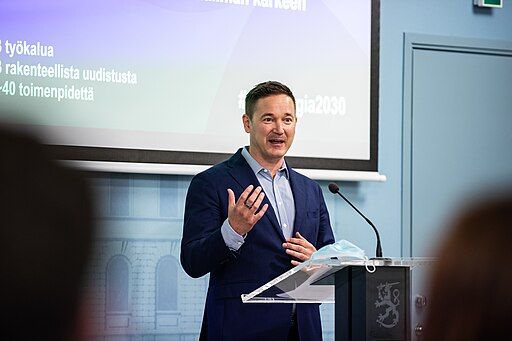The Future of the Decentralised Workplace
Over the summer we spent a lot of time scrubbing our thesis on Work and Knowledge.

Over the summer we spent a lot of time scrubbing our thesis on Work and Knowledge. We dug into many different interesting themes, but spent the most time looking at what we call the Decentralised Workplace. Below are some of our thoughts on the subject that we would like to share with you.
Decentralised Workplace Thesis
The team continues to carry out a number of thesis “deep dives” on the key themes within our four sectors of focus (Work & Knowledge, Capital & Finance, Health & Wellbeing, Gaming, and Community & Leisure). In this month’s newsletter, we have chosen to focus on the “Decentralised Workplace”, one of the most exciting and important themes within the Work & Knowledge sector. There is much to unpack, but in the interest of concision, we will focus on explaining what we mean by the Decentralised Workplace, its increasing relevance and the levers that make it one of the cornerstones of the future of work.
Distinction between the Centralised and Decentralised Workplaces
The traditional form of workplace has been the centralised workplace, characterised by large physical offices where 90%+ of a company’s workforce would work on site. While the centralised workplace is typified by the concentration of people and resources in specific locations, the Decentralised Workplace is characterised by the lack of constraints.
The Decentralised Workplace is dismantling our traditional perception of work. Where you work, how you work, and what you are doing has become extremely dynamic, providing a lot more power and choice to the employee. While remote working has been a trend for many years, the COVID-19 pandemic has led to its broad acceptance across most industries.
Why now?
The drive towards remote working is due to the evolution and (the partially COVID-induced) adoption of a host of tools, which have removed the requirement to be physically present in the same location as your co-workers. For example, collaboration tools providing chat, video, and asynchronous communication are eating away at the need for physical meetings and ultimately causing the death of geography. Teams working remotely are proving to be as efficient as teams working together in situ. The growth of cloud-based software, which allows access to databases, project management tools, and workflows that are constantly updated, has facilitated this. Additionally, broadband infrastructure is getting better and better at creating the odd reality that connectivity can be stronger outside a central office location, making the home sometimes a better place to stay in touch and communicate with your partners across the globe. We are witnessing an acceleration in both the speed of creation and adoption of these tools, with many products that were relatively unknown pre-COVID becoming ubiquitous.
Many of these tools started off as consumer tools that worked their way into the office environment (for example, 90% of NHS staff use WhatsApp), but now employees are using business tools on a personal basis (for example, families setting up Slack workspaces to communicate and coordinate). Work-life and personal-life are blurring together.
Why The Decentralised Workplace is here to stay:
Not every industry and sector that has been radically reshaped by the COVID-19 pandemic will stay on its current trajectory in a post-pandemic world. We believe that there is an inexorable movement from the centralised to the Decentralised Workplace, as this pandemic was an accelerant rather than the architect of this transformation.
The Decentralised Workplace exists not simply out of necessity but because it offers a number of distinct benefits over the traditional centralised model. These include:
- Access to talent: There is a global war for talent and the pool is spread more broadly geographically than ever before.
- Cost benefits (salaries, offices, etc): There has been a broad disparity in remuneration between different cities, different countries, and rural/urban dwellers. Organisations can now optimise the cost of talent in different regions to the value they are able to bring. Additionally, the cost of running a centralised workforce in a city with high office expenses has meant larger organisations have worked hard to spread these costs by having multiple offices across multiple geographies with different cost properties. In this new world of decentralised work, the home office is a continued evolution of the decomposition of the office space into lower-cost components.
- Increased productivity: Although working in a centralised environment does create a lot of efficiencies, it also brings with it numerous inefficiencies including time spent commuting to work, inefficient in-person communication, and various distractions. A decentralised workplace aims to alleviate these inefficiencies.
- Improved employee satisfaction: Not only do organisations want to hire the best talent, they also want to retain them. A hybrid work model gives employees more freedom about when they can work and where they can work from. This increased autonomy to employees allows them to fit work around the rest of their lives. Offering employees flexibility improves job satisfaction, which results in improved employee happiness, reduced staff turnover, and a workforce that is highly-driven to help a business achieve its goals.
At Moonfire, we’re passionate about technological transformation that increases access, efficiency, and service quality - our ‘Golden Triangle’. As part of our thesis research, we have unearthed an incredibly diverse and exciting group of companies that are seeking to power the Decentralised Workplace of today and tomorrow that fall within this Golden Triangle.
Next month, we will continue our discussion of the Decentralised Workplace and will focus on developments in Productivity & Communication tools.
Portfolio News

The Moonfire team has been busy this past month evaluating, meeting, and ultimately investing in a number of the amazing companies that have been accepted onto the Summer 2021 batch of the Y Combinator programme. While the record 377 companies in this latest intake held their demo days on 30th August and 1st September, it’s critical for us to get in front of the best companies as early as possible.
To more effectively capitalise on these opportunities, Mike has created purpose-built sourcing and screening infrastructure, which has proved to be a major source of advantage for us. Using this infrastructure, we’ve been able to automate the initial sourcing and screening processes so that all of the companies in the relevant sectors and geographies were automatically added to our prospect list, usually before the companies announced they were in YC. This made the process of evaluating such a large cohort extremely efficient. Consequently, we were able to initiate conversations with a number of fantastic founders before they had even started their fundraising process.
The efficiency gains we reaped from Mike’s technical architecture were compounded by the thesis deep dives we’ve been doing over the past several months. The time and effort that we spent refining our thoughts on our sectors of focus have enabled us to be able to move incredibly quickly and with great conviction.
We look forward to sharing more details about our new portfolio companies in due course!
Moonfire Zoom Series

This month, we hosted Ilkka Paananen, the founder of Supercell, who shared his views on building teams and the role of the CEO.
We had an extremely interactive session with some great questions from senior leaders within our portfolio companies. Below are some of the key takeaways from the session:
- Building a strong team culture is everything - don’t let anyone (either internal or external) disrupt your team’s culture.
- Team building is often a case of trial and error and it’s important not to overcomplicate team construction.
- Keep focussed on your key objectives and don't be distracted by exciting side projects.
- Hiring is difficult and when you realise you have hired someone who is not a cultural fit, it’s important to have an honest conversation about this lack of alignment.
- There will always be competition for shared resources, regardless of a company’s maturity.
Thanks for reading and keep an eye out for next month's edition.
Best,
Mattias
🌓🔥

